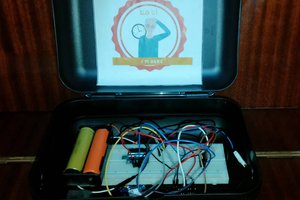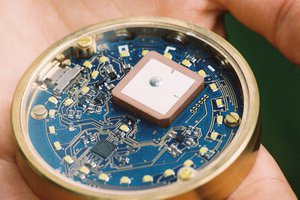The Source Idea
Most people have phones. So, what if instead of relying on people to identify people, we can use phones? This is exactly the idea behind the contact tracing standard being developed by Apple and Google, in a partnership. Their idea is to use a phone's BLE (Bluetooth Bow Energy) radio to transmit and scan for encrypted data. In the case of a positive diagnosis, a user can see if and when they've been in contact with someone with COVID-19, but not who, which allows for completely private and secure contact tracing.
In theory, it makes sense. But, in practice, there are some issues with this approach:
- Not everyone has a phone.
- Some phones do not have a BLE radio or compatible software.
- Phones have poor battery life (1-2 days at best)
With this in mind, I came up with a solution: Project Tracer. It is a small sized, low-power device which implements the aforementioned contact tracing standard.
What Are the Benefits?
As opposed to other methods of contact tracing, Project Tracer has multiple benefits.
- 🔐 Ensures User Privacy
Unlike other methods of contact tracing that use machine vision or GPS, no personally-identifying data will ever be recorded or stored by the device. All of the information used to notify others of potential exposures is randomly generated and encrypted.
- 🔋 Long Battery Life
Project Tracer provides an extremely low-maintenance method of contact tracing as opposed to phones. While a user's phone may run out of battery after less than a day, Project Tracer's projected power consumption can keep the device running for almost 5 days. In fact, the average power consumption is so low that the device can be charged by a single solar cell!
- 👐 Simple Setup
Just tap a button, connect to the hotspot, and configure the device!
- 💲 Low Cost
While the BOM cost for a single device in individual quantities is high (about $13), bulk pricing can bring the price down to something as low as $5 per device.
How Does it Work?
Before getting into the project, it's important to understand the fundamental principles which are the backbone of the project:
- Encryption is a one-way transformation that can only be reversed by the encryption key.
- Cryptographically secure random numbers are completely random and cannot be predicted in any way.
With these concepts in mind, Here's how the system works.
Every day, a random number called the TEK (Temporary Exposure Key) is generated. From the TEK, two additional keys are generated: the RPIK (Rolling Proximity Identifier Key) and AEMK (Associated Encrypted Metadata Key).
Every 10 minutes, the RPIK is used to encrypt the string "EN-RPI", along with the UNIX epoch time at encryption into what's called an RPI (Rolling Proximity Identifier). Additionally, the system will use the AEMK and the RPI to encrypt some additional metadata into what's called the AEM (Associated Encrypted Metadata). The AEM and RPI are then combined and transmitted by the integrated Bluetooth Low Energy Radio to nearby devices.

When the device would like to check whether or not it has been exposed to an individual with COVID-19, it simply starts by downloading the TEKs which have been submitted to a keyserver. For each TEK downloaded, it derives its respective RPIK and AEMK and attempts to decrypt the data that has been scanned from nearby devices. Due to the nature of Bluetooth (radio waves only travel so far), it is possible for the device to determine whether or not the user has been exposed to someone with COVID-19.
If you want a more in-depth read, and also how exactly to implement the standard, please take a look at some of the documents here. The part of the standard outlined above is the Cryptography Specification, v1.2.
 Shranav Palakurthi
Shranav Palakurthi
 Yassin Ali Salah Ali
Yassin Ali Salah Ali
 Sammy Herring
Sammy Herring
 Antoine Pintout
Antoine Pintout
 Chris Finn
Chris Finn